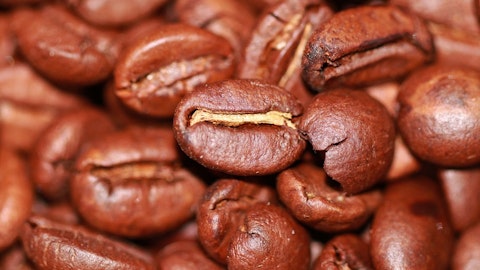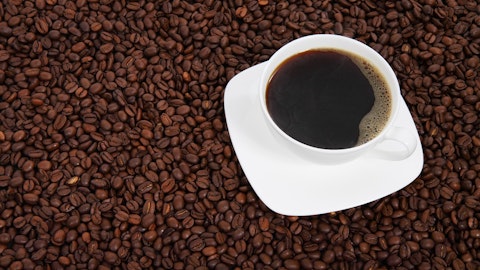Gerry Sweeny: Got it. Density is key to route-based business. So I get that. That is it from me. I appreciate it. Thanks.
John Moore: Thanks, Gerry.
Brad Bollner: Thanks Gerry.
Operator: [Operator Instructions] Our next question will come from Eric Des Lauriers with Craig-Hallum Capital Group. You may now go ahead.
Eric Des Lauriers: Great. Thank you for taking my questions and congrats on the SKU rationalization progress here?
John Moore: Thanks, Eric.
Eric Des Lauriers: My first question is kind of, diving a bit more deeply into that SKU rationalization and the progress there. So, I understand that you’re expecting to have, all the legacy SKUs sort of fully out by the end of Q1 of fiscal ’25. Have you finalized which SKUs and brands will be included in the new tiered offerings? Have you sort of fully built out what those tiers will look like?
John Moore: We have in terms of the first two tiers where most of the volume is. So, essentially, in the traditional tier, we’ve established the Farmer Brothers brand as our traditional tier offering. And then what we’re referring to as the premium tier, we have the Boyd’s brand positioned to take that space. We’re still working on the brand expression in the specialty space, but those will be essentially the three defined tiers. The value propositions presented by those are pretty much well defined. And essentially, now we’re in the brand building effort in the specialty side. But the Farmer Brothers and the Boyd’s brands are established and will be the brands of choice for those other two tiers.
Eric Des Lauriers: Got it. And understand that we’re at sort of more than half of your inventory now is these new SKUs. You mentioned the obvious sort of delay of getting these SKUs in the inventory and then out into the market. I’m just wondering if any of these newer tiers have gone out into the market, and if there’s been any sort of early feedback from customers, or any sort of early insights to ascertain from that?
John Moore: No, that’s a great question. I would say that the early indications are that we’ve managed thus far to thread the needle when it comes to positioning the new products into the market space. Keep in mind that both Farmer Brothers and Boyd’s had been out in the market in the past and were essentially distilling down other brands that had been out. But even in those markets, they may have had some exposure to Farmer Brothers and Boyd’s. So the resistance has not been significant. Having said that, on the manufacturing side and the planning side, the efficiencies are definitely there and being realized. So you can imagine when it comes to procurement, the effort and attention that you need to source when you’ve got half of the coffee SKUs that you had in the past is radically reduced, and you can really focus on adding value there.
When it comes to the manufacturing and production side, even more so, the planning of manufacturing on the lines, is much more straightforward. You can realize the efficiencies by not turning over your line changes as often. And so there, we’ve seen a great deal of efficiency gained, when it comes to the manufacturing in Portland. Also, the fact that we’ve been able to consolidate the vast majority of the manufacturing in the Portland facility has made that facility much more efficient in and of itself. So we’re seeing lots of advantages there, where I think we’ll continue to see efficiencies gained in the future. As that stretches through the chain and it goes into the distribution center and into the branch level and onto the trucks, ultimately, we’ll see a much more streamlined capability.
So as much as producing things and getting to the right branch and to the right truck, we have improved that. Part of the ability to improve that has been, yes, communication, additional infrastructure and resources, but it’s also the fact that the offering set has been radically reduced. So we’re going to see efficiencies when it comes to the amount of space we need, the amount of gas we burn. Every single piece of the puzzle will be more efficient as we continue to roll this out.
Eric Des Lauriers: That’s great color and very great to hear. Last question on the new tiered offerings here. Do you anticipate any meaningful gross margin difference among the tiers? I understood that specialty is still a work in progress here, but just as you see it now, do you anticipate any meaningful gross margin difference among the tiers?
John Moore: No. Honestly, keep in mind, we have existing business associated with these tiers, and we are as much collapsing multiple brands into singular brands as anything. So we already have gross margin data around where these brands have been positioned, and as such, I think we’re able to maintain consistency in the gross margin across the three brand tiers.
Brad Bollner: Brad, if you want to speak to that. Yes. Well, what I would call out, Eric, your question, the answer is definitely, I think we’re thinking of the same margin profile within each tier. But that said, the simplification of our product offering on the back end, is going to allow us to be very intentional with our pricing in a way that will raise all the votes. So there’s opportunity to find inefficiencies in where individual customers are priced, and move them into the new system. So there’s potential to derive more value. Not to the extent that we’ve done over the last year, with 600 basis points. This isn’t going from zero to full, but it is an opportunity for us to be much more strategic with the pricing on an ongoing maintenance basis.





